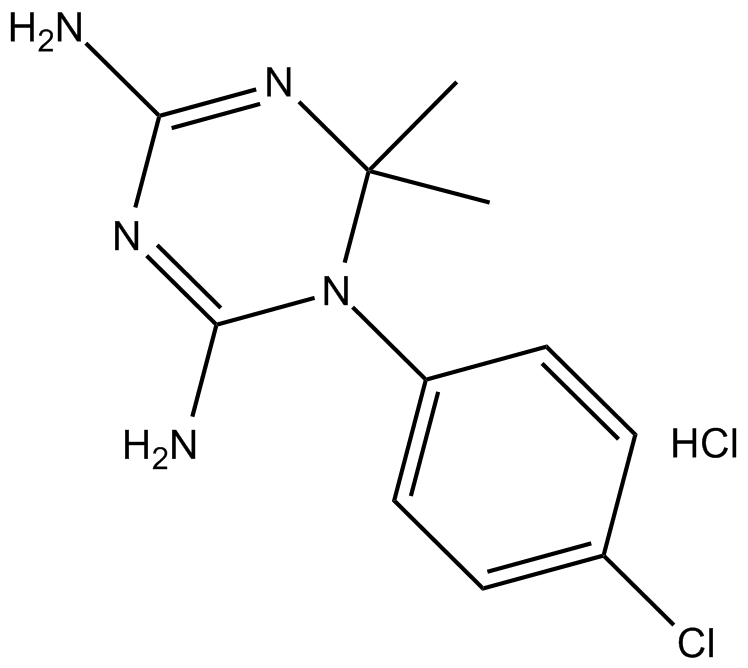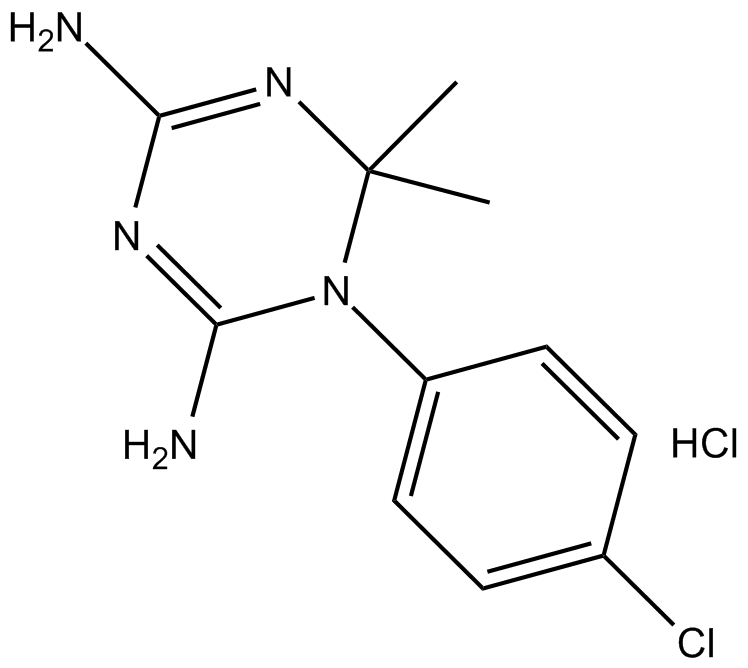Cycloguanil (hydrochloride)
Cycloguanil is an inhibitor of dihydrofolate reductase (DHFR)[1].
Dihydrofolate reductase (DHFR) is an enzyme that involved in reducing dihydrofolic acid to tetrahydrofolic acid. DHFR plays a critical role in regulating the amount of tetrahydrofolate in the cell, which are essential for purine and thymidylate synthesis important for cell proliferation and cell growth. DHFR also plays a central role in the synthesis of nucleic acid precursors and salvage of tetrahydrobiopterin from dihydrobiopterin [2].
Cycloguanil is the active metabolite of proguanil produced by the cytochrome P450 (CYP) [3]. Cycloguanil showed activity against P. falciparu. Cycloguanil inhibited the activity of dihydrofolate reductase (DHFR) with the Ki values of 0.3 and 1.5 nM for Plasmodium and human forms, respectively., Cycloguanil prevented the production of tetrahydrofolic acid, an essential coenzyme involved in DNA and RNA synthesis, by blocking DHFR activity.
References:
[1] Foote S J, Galatis D, Cowman A F. Amino acids in the dihydrofolate reductase-thymidylate synthase gene of Plasmodium falciparum involved in cycloguanil resistance differ from those involved in pyrimethamine resistance[J]. Proceedings of the National Academy of Sciences, 1990, 87(8): 3014-3017.
[2] Blakley R L. Dihydrofolate reductase[J]. Encyclopedia Of Molecular Medicine, 1984.
[3] Birkett D J, Rees D, Andersson T, et al. In vitro proguanil activation to cycloguanil by human liver microsomes is mediated by CYP3A isoforms as well as by S‐mephenytoin hydroxylase[J]. British journal of clinical pharmacology, 1994, 37(5): 413-420.
| Physical Appearance | A crystalline solid |
| Storage | Store at -20°C |
| M.Wt | 288.2 |
| Cas No. | 152-53-4 |
| Formula | C11H14ClN5·HCl |
| Synonyms | Chloroguanide Triazine,NSC 3074 |
| Solubility | ≤5mg/ml in ethanol;20mg/ml in DMSO;5mg/ml in dimethyl formamide |
| Chemical Name | 1-(4-chlorophenyl)-1,6-dihydro-6,6-dimethyl-1,3,5-triazine-2,4-diamine, monohydrochloride |
| SDF | Download SDF |
| Canonical SMILES | CC1(C)N=C(N)N=C(N)N1c(cc1)ccc1Cl.Cl |
| Shipping Condition | Small Molecules with Blue Ice, Modified Nucleotides with Dry Ice. |
| General tips | We do not recommend long-term storage for the solution, please use it up soon. |
Quality Control & MSDS
- View current batch:
-
Purity ≥ 95.00%
- COA (Certificate Of Analysis)
- MSDS (Material Safety Data Sheet)
Chemical structure









